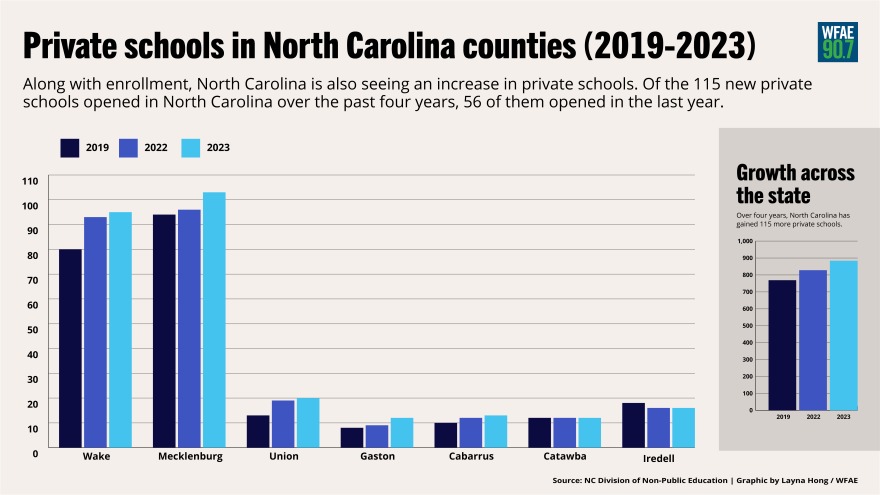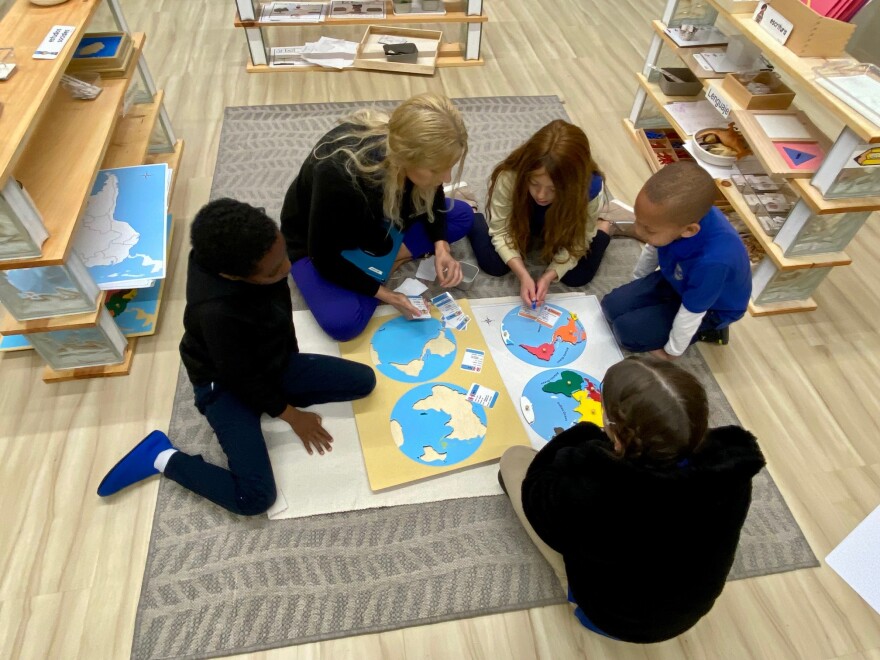Enrollment in North Carolina’s private schools increased by 10% in the school year that just ended, a new state report shows, and an expanded private school voucher program from Republican legislators could send enrollment higher.
Last year, the state had 126,768 students enrolled in 884 private schools. The annual tally of private schools shows North Carolina has added 115 schools over the past four years — 56 of them just last year. Enrollment is up 24% over the past four years.
Just over two-thirds of last year’s private-school students attended religious schools.
The growth comes as state lawmakers have steadily expanded the amount of public money available to subsidize private-school tuition. The Opportunity Scholarship program was created in 2013 to help low- and moderate-income families afford alternatives to public schools. Funding for the program has increased annually, to almost $95 million in 2022-23.
The total number of students in North Carolina’s private schools rose 3% in 2008, then held fairly steady at just under 100,000 until 2017. After that, small, steady increases turned into a sharp climb when the COVID-19 pandemic disrupted public schools: private enrollment jumped just over 7% in 2021-22 and 10% last year.
A plan that has the support of the Republican majority in the General Assembly would remove many of the limits on Opportunity Scholarships and make families of all income levels eligible. Funding would rise to $176.5 million for the current budget year, with steady increases topping out at more than $500 million a year by 2031.

Vouchers and new schools
Opportunity Scholarship amounts are tied to family income and the state’s average per-pupil spending for public schools. Last year’s average award was around $4,000; for the coming year, the maximum will be $6,492.
That’s not enough to cover the bills at Charlotte’s most prestigious private schools, where tuition can run $30,000 or more per year. Those schools traditionally have long waiting lists.
And starting a new private school can be costly. Dria Etienne opened ILIM School, a language-immersion/Montessori private school in Pineville, in 2021. She told WFAE last year that she raised $2 million to launch the school and would operate at a loss until enrollment reached 80 students. Tuition there ranges from $15,500 to $17,500 a year. State reports show five ILIM students received a total of $30,840 from Opportunity Scholarships.
But some schools rely more heavily on vouchers and serve very small numbers. Dozens listed in the state’s private school directory report having student bodies about the size of one classroom in a typical public school. Teaching Achieving Students Academy, which got $126,444 in public vouchers for 22 students last year, apparently operates out of one classroom in another small private school on North Graham Street.
It’s unclear whether the growth in private school enrollment will benefit students academically. The state requires public schools, including charter schools, to report data on test scores, teacher credentials and other accountability measures. But private schools have to report almost nothing to the public, even when receiving public money.

District trends
Private schools in Wake and Mecklenburg, the state’s two largest districts, account for about 22% of the total enrollment — roughly proportional to their share of public school students. Both counties have seen growth in recent years, though not quite as large as the statewide trends.
Wake currently leads the state for private-school enrollment, with 21,699 students in 95 schools. Its enrollment grew 4% last year and 17% in four years.
Mecklenburg has the most private schools — 103 — with a total enrollment of 20,857. It saw one-year enrollment growth of 7% and four-year growth of almost 13%.
In the Charlotte region:
- Union County has seen the Charlotte region’s most dramatic growth in private-school enrollment, increasing by 58% in four years. The total went from 2,256 enrolled in 2019 to 3,555 last year, as the number of private schools rose from 13 to 20.
- Iredell County logged about 1,600 students in private schools last year, a 12% one-year increase and a 35.5% four-year change. But the number of schools dropped from 18 to 16.
- Gaston County went from eight private schools to 12 over the last four years. Three were added last year. Most of that county’s four-year enrollment growth also occurred last year, when it jumped from 2,235 to 2,491.
- Cabarrus County added three private schools over the last four years, for a total of 13. Enrollment increased 24% during that time.
- Catawba County has the same number of private schools — 12 — as it had four years earlier, but enrollment is up 8%.




